
Meridian is the seventh largest city in the U.S. state of Mississippi, with a population of 41,148 at the 2010 census and an estimated population in 2018 of 36,347. It is the county seat of Lauderdale County and the principal city of the Meridian, Mississippi Micropolitan Statistical Area. Along major highways, the city is 93 mi (150 km) east of Jackson, Mississippi; 154 mi (248 km) southwest of Birmingham, Alabama; 202 mi (325 km) northeast of New Orleans, Louisiana; and 231 mi (372 km) southeast of Memphis, Tennessee.
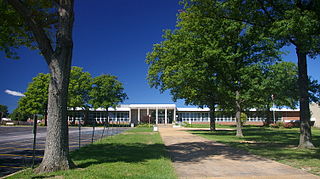
Affton High School is a public comprehensive high school in Affton, St. Louis County, Missouri that is part of the Affton School District.

Meridian Museum of Art is an art museum located at 628 25th Avenue, Meridian, Mississippi. The building was added to the National Register of Historic Places in 1979 and declared a Mississippi Landmark in 1985. The building originally served as the home of the First Presbyterian Church of Meridian until the city of Meridian bought the building in 1911 and turned it into a Carnegie Library in 1913. The city originally constructed two Carnegie libraries — one for whites and one for African-Americans; the building currently housing the Meridian Museum of Art served as the white library. In 1970, after the libraries integrated and moved to a new location, the vacant building at 628 25th Avenue was transformed into the Meridian Museum of Art and still operates today.
The Revere Local School District is a school district located in northeastern Ohio, between the cities of Akron and Cleveland, was formed in the early 1950s after the communities of Bath and Richfield voted to combine their two smaller school systems. The District is broken up into four schools, Revere High School, Revere Middle School, Bath Elementary School, and Richfield Elementary School.

The Old Lake Worth City Hall, also known as the Lake Worth City Hall Annex, is a historic site in Lake Worth, Florida. It is located at 414 Lake Avenue.

The Cummins School is a historic former school building in Cincinnati, Ohio, United States. Built in 1871 in the neighborhood of Walnut Hills, it was later used as a model for the construction of other city school buildings.
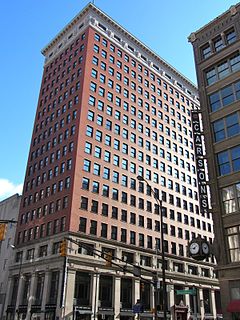
The Barnes and Thornburg Building is a high rise in Indianapolis, Indiana originally known as the Merchants National Bank Building. In 1905, the Merchants National Bank and Trust Company engaged the architectural firm of D. H. Burnham & Company of Chicago to design a new bank headquarters on the southeastern corner of the Washington and Meridian streets, the most important intersection in Indianapolis. Initial occupancy of the lower floors took place in 1908, while the upper floors were not completed until 1912.

Wiley H. Bates High School is a historic black school building in Annapolis, Anne Arundel County, Maryland. It was completed in 1932, and replaced the original Annapolis Colored High School. The school building is named after Wiley H. Bates, a prominent African-American businessman and community leader whose financial donations enabled the school to be built.

Lincoln School in Canton, Missouri is a former school for the African-American children of Canton and surrounding areas of Lewis County, Missouri. Built in 1880, it served the community until 1955 when it closed in the aftermath of the landmark Brown v. Board of Education ruling by the U.S. Supreme Court. The school was listed on the National Register of Historic Places in 1983. Currently only the exterior is available for public viewing.

Congregation Beth Israel in Meridian, Mississippi, is a Reform Jewish congregation founded in 1868 and a member of the Union for Reform Judaism. The congregation's first permanent house of worship was a Middle Eastern-style building constructed in 1879. The congregation moved to another building built in the Greek Revival style in 1906, and in 1964 moved to a more modern building, out of which they still operate.

Crawfordsville High School is a former public high school erected in 1910 on East Jefferson Street in Crawfordsville, Montgomery County, Indiana, and was a part of the Crawfordsville Community Schools. The building was expanded in 1914, 1921, and 1941 to provide additional classrooms, an auditorium, and a gymnasium. In 2000 the old school building was converted to a multi-use facility of offices, residential housing, and a fitness center. The former high school building was added to the National Register of Historic Places in 2003. A new Crawfordsville High School facility opened at One Athenian Drive in 1993.

Buffalo High School, also known as Independent School District #1 and Buffalo Elementary School, is an historic building located in Buffalo, Iowa, United States. It was listed on the National Register of Historic Places in 2005.

Bettendorf–Washington School, also known as the Bettendorf Park Board Fine Arts Annex, was a historic building located in Bettendorf, Iowa, United States. It was listed on the National Register of Historic Places in 1984.
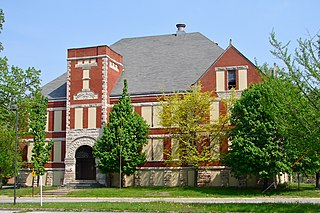
Lincoln School was a historic building located in Rock Island, Illinois, United States. It was designated a Rock Island Landmark in 1984, individually listed on the National Register of Historic Places in 1985, and became part of the Broadway Historic District when it was listed on the National Register in 1998. It was torn down in 2012 and delisted from the National Register in 2020.

Jefferson School, also known as East Elementary and Clifton Forge Elementary East, is a historic school building located at Clifton Forge, Alleghany County, Virginia. It was built in 1926, as a rectangular two-story building is clad in running-bond brick in the Colonial Revival style. It sits on a raised concrete foundation and has ribbons of small-paned double-hung windows and a recessed front entrance.
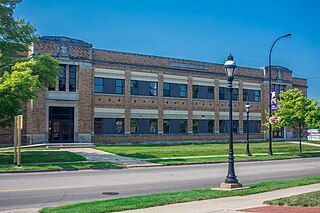
The former Fremont High School is a former school building located at 204 East Main Street in Fremont, Michigan. It was listed on the National Register of Historic Places in 2013.
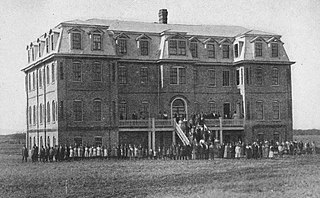
Okolona College, also known as Okolona Industrial School, and Okolona Normal & Industrial School, was a college for African Americans in Okolona, Mississippi, Chickasaw County, Mississippi. It was added to the National Register of Historic Places on August 9, 2002. The school is located on Mississippi Highway 245 1.1 miles north of the junction with Mississippi Highway 32 and Mississippi Highway 41. It is part of The Okolona College Historic District.

The Warren County Administration Building, formerly Indianola High School, is located in Indianola, Iowa, United States. The first high school in town was designed by the Des Moines architectural firm of Proudfoot & Bird. It was completed in 1904 and an annex was added in 1917 because of increased enrollment. Irving School (1876), housed grades 1-8 and was condemned by the city council in 1924. The Independent School District of Indianola decided to build a new building to house the high school and elementary grades. The Minneapolis architectural firm of Grahn & Rathurst was chosen the design the $180,000 building. Completed in 1925, the first floor housed grades 1-6 and the second floor housed grades 10–12. The old high school building, no longer extant, became the junior high school building. The interior of the brick, Late Gothic Revival structure has a U-shaped hallway with a gymnasium/auditorium in the middle and classrooms on the outer perimeter. After a new high school was built in Indianola, this building was renovated between 1997 and 1999 for the Warren County Administration Building. It was listed on the National Register of Historic Places in 2002.
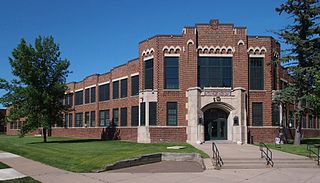
Franklin Junior High School is a historic former school building in Brainerd, Minnesota, United States. The core sections were built in 1932 and extensions were added on in 1954 and 1962. The school closed in 2005. In 2008 the building reopened as the Franklin Arts Center, which leases residential, work, and commercial space to local artists.

Spencer High School and Auditorium, also known as Spencer Middle School and Auditorium, is a historic building in Spencer, Iowa, United States. The building was listed on the National Register of Historic Places in 2010.




















